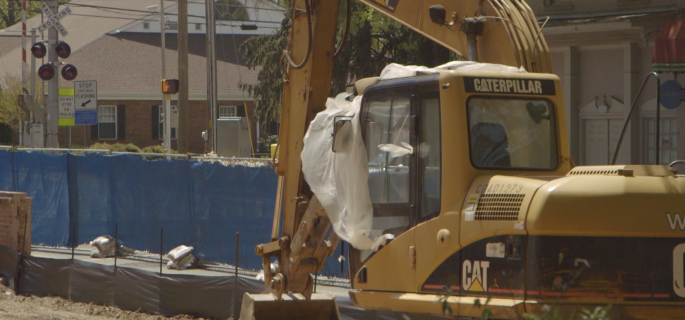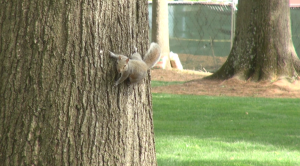The impact of construction on Elon’s environment

As you enter Elon University’s campus from Williamson Avenue, it’s hard to miss the construction site that will eventually become the new School of Communications. What may be easier to overlook is the impact sites like these have on the environment.
Paul Moersdorf, an adjunct professor in the Environmental Studies department had issues with the way the construction site for the Inman Admissions building affected the environment. Now he sees some of the same issues with the new School of Communications construction site.
“I’m pretty convinced that any tree on the campus itself is in danger of being cut down in the name of progress and in the name of future,” Moersdorf said.

Some squirrels that live in the trees near the McEwen Communications School may have needed to find a new home due to construction
Moersdorf has taught at Elon for nearly five years and says people don’t consider how much construction sites at Elon, like the expansion of the School of Communications, hurt the environment.
“As you do construction obviously you are moving things in you are shifting earth you are doing all those kinds of things so you have radically changed a habitat, a habitat for whatever plants and animals were there.”
Some of the habitats endangered by construction lie within trees that have also become a staple of Elon’s visual appeal. Moersdorf estimates over twenty-five trees were cut down because of the construction on the School of Communications. He remembers driving past the construction site in its early stages and the dismay he felt when he saw the fallen trees.
“I noticed the amount of logs that were piled up there, the tree trunks and how wide they were the diameter of those tree trunks. It was amazing it was like someone had took a friend of mine away.”
Moersdorf says cutting down large trees in the name of expansion takes away an essential part of the environment’s sustainability. “As you can imagine, the larger the tree, the better job it’s doing of absorbing that carbon dioxide that’s part of photosynthesis. It absorbs carbon dioxide, it absorbs water out of the ground and it forms the leaves and the leaves will end up as being nutrients to the ground when they fall,” Moersdorf said.
The Kirkland construction company declined to comment. ELN reached out to Gerald Whittington, a member of the Elon University Facilities Master Plan Committee. He responded with the following statement:
“As the university grows, its facilities need to grow as well. So, a larger facility like the School of Communication was inevitable. One of the reasons why it was put in that location was to keep a vibrant undergraduate program on that side of campus, rather than moving it to another part of the campus and have NO classroom activity intermingled with residence halls. Further, over the last decade we have planted more than 1,000 new trees on the campus. So, while it might seem regrettable to lose those trees we did take down, we planted immensely more trees than we lost. So, in a net consideration, we were still vastly ahead in carbon offsets and habitat expansion, in that regard.
While we are looking for even more environmental initiatives to consider for adoption, it is important to note what we have already committed to. We already have adopted all environmental regulations required by the state and federal government (including energy, waste stream and similar considerations) and additionally, we have voluntarily adopted LEED certification for all new facilities as well, which go significantly beyond the requirements of the state and federal government. Further, as examples, we have introduced passive solar systems for domestic hot water (as retrofits to existing buildings), a geothermal array for the Colonnades residential area, cross connected Lake Mary Nell and Lake Verona with a massive underground piping system to aid in proper water management for irrigation, and introduced a solar farm on university property. Additionally, we have dedicated an old growth forest (the Elon Forest) as a preserve for natural habitat and proper scientific research. None of these were requirements by outside agencies, but were done to improve the university’s commitment to its footprint, with respect to environmental concerns.”












